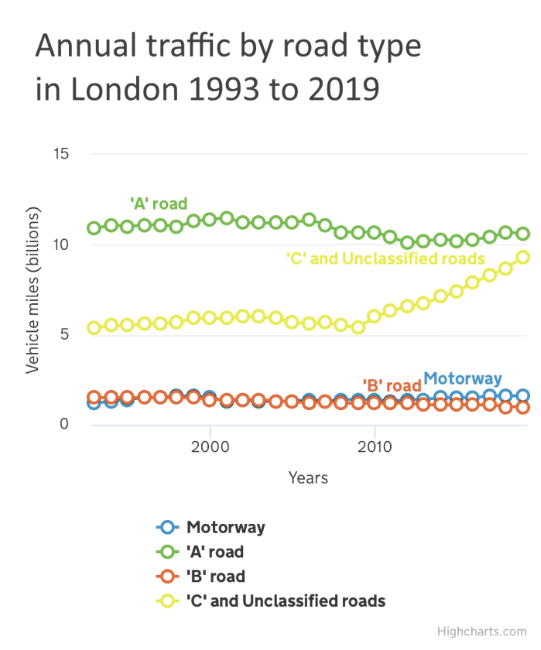Forum topic: Fox Lane low-traffic neighbourhood
Fox Lane low-traffic neighbourhood
Julia Mountain
23 Oct 2020 01:44 #5670
- Julia Mountain
-

Share
![]()
![]() Share by email
Share by email
Fox Lane low-traffic neighbourhood
Karl Brown
23 Oct 2020 09:49 #5671
- Karl Brown
-

Share
![]()
![]() Share by email
Share by email
Fox Lane low-traffic neighbourhood
Alan Thomas
23 Oct 2020 09:58 #5672
- Alan Thomas
-

Share
![]()
![]() Share by email
Share by email
I have been commuting to work in Enfield Town by car since March, going via the back roads such as Broad Walk. I estimated that the LTN would add 90 seconds to my journey as I now go via Aldermans Hill and the Green Lanes. But I don't think it has made much difference. The journey takes 16-20 minutes, including queuing on Aldermans Hill and London Road by the Dugdale. I recognise that some of us are more inconvenienced than others, but when some local people make wild exaggerations on social media about constant gridlock on the roads, they do not add anything positive to the debate.
No offence intended, but the above makes absolutely no rational sense to me. How could such a diversion have been 'estimated' to add '90 seconds' to that journey? It would simply not be possible. It takes you - literally! - miles out of your way, and puts you onto roads where you are moving further away from your final destination before you can get back on track, it puts you onto roads where you simply do not need to be, and at pinch points (EG The Triangle and Palmers Green high street) where your presence is adding to congestion, pollution and danger.
But more to the point, the people who support these schemes don't want you to be using your car to commute from Conway Road to Enfield! They want you to walk, cycle, take public transport or any combination thereof. Perhaps it is worth considering how long *that* diversion will add to your journeys, and what its impact on your free movement will be? Fox Lane LTN is the thin end of the wedge.
Fox Lane low-traffic neighbourhood
Colin Younger
23 Oct 2020 15:36 #5673
- Colin Younger
-

Share
![]()
![]() Share by email
Share by email
That is the potential effects on crime raised by the Designing Out Crime Office at Bowes Road Police Station.
I attacha slightly edited version of their response (removing some elements nt directly relevant).
Fox Lane low-traffic neighbourhood
Karl Brown
24 Oct 2020 09:57 #5675
- Karl Brown
-

Share
![]()
![]() Share by email
Share by email
Fox Lane low-traffic neighbourhood
Adrian Day
24 Oct 2020 12:55 #5676
- Adrian Day
-

Share
![]()
![]() Share by email
Share by email
Fox Lane low-traffic neighbourhood
Tony Maddox
24 Oct 2020 15:09 #5677
- Tony Maddox
-

Share
![]()
![]() Share by email
Share by email
Alan Thomas wrote: "It takes you - literally! - miles out of your way, and puts you onto roads where you are moving further away from your final destination before you can get back on track, it puts you onto roads where you simply do not need to be, and at pinch points (EG The Triangle and Palmers Green high street) where your presence is adding to congestion, pollution and danger....Fox Lane LTN is the thin end of the wedge."
I might have thought this and I don't know where Julia lives, obviously, but taking the midpoint of Conway Rd as a starting point, her new commute is 0.51km or 0.32 miles longer (Ordnance Survey online). If she lives at the Ulleswater Rd end, it is shorter. Her old commute would also have involved pinch points (Winchmore Hill Green etc.) which are uncontrolled by traffic lights and probably more dangerous for drivers and pedestrians alike.
In terms of wedges, Alan is correct in that it is the stated policy of national, regional and local governments to reduce car mileage (largely as a public health measure) and, over the coming years, there will be increasing regulatory and financial disincentives to drive for short journeys and at particular times of the day. One of the reasons for that is that we are at the thick end of this wedge:
and another two years will see the traffic on unclassified roads in London at the same volume as "A" roads. All this has happened in the last 10 years, partly due to satnav, partly because the cost of driving has been static (ish). The increased mileage is also greater than the increase in either number of cars or population, so we have all been driving more.
If we do nothing, then this will eventually self-limit due to congestion and traffic volume and people will be forced to find other methods of transport in any case. It just seems more sensible for us all to consider ways we could drive less now and thus avoid the attendant (well-known) problems of more years of increasing traffic.
Fox Lane low-traffic neighbourhood
David Hughes
24 Oct 2020 16:30 #5678
- David Hughes
-

Share
![]()
![]() Share by email
Share by email
Furthermore I'm a little bewildered by the fact that as a society very, very much younger people continue to reach destinations, perhaps especially work destination, in driver-only vehicles when in London there are usually perfectly good alternatives like buses and trains, backed by walking or cycling. Cars are wonderfully adaptable, but given that even now they emit dangerous emissions which are especially hard on children, you would think everyone would think twice about whether they really need to use a car when there are alternatives.
Perhaps someone who does reach work be car, but could walk, cycle or use public transport, would like to make a case.




